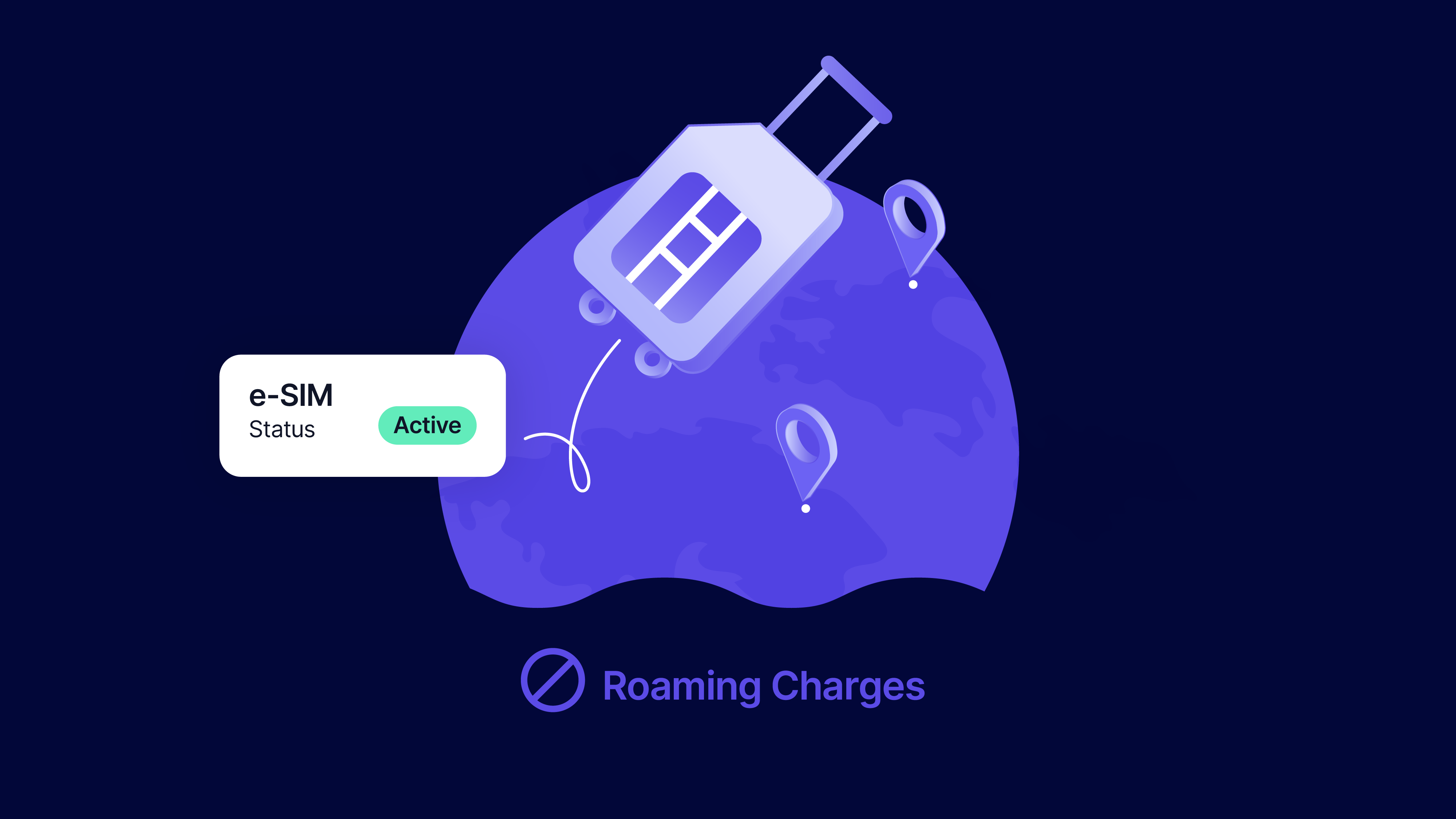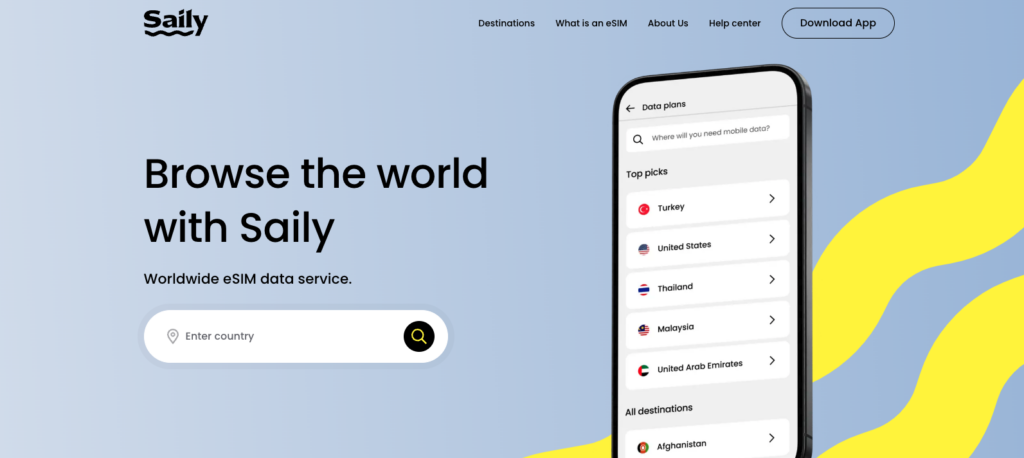
How to Avoid Data Roaming Charges when Traveling in 2025

Traveling abroad can quickly become costly with unexpected data roaming charges. Learn how to minimize or avoid these expenses with practical tips and recommendations.
In this article we’ll wander through the sometimes financially hazardous landscape of roaming charges and examine details like:
- What is data roaming
- A range of tips and tricks to save you money
- The 3 main types of roaming charges
- And, we’ll even include a short review of Saily, one of the top eSIM service providers.
Data Roaming When Traveling – Beware, Here There Be Dragons!
Returning from vacation or an unforgettable business trip abroad, should be about the memories you’ve made, the people you’ve met, and the experiences you’ve had – not about the size of your phone bill.
Sadly, if you don’t have the right roaming plan on your smartphone or mobile device, that could easily be the case.
(Ask yourself, did you really need to watch the big game on your phone while lazing by the hotel pool in South Africa?)
What is Data Roaming?
Data roaming occurs when your mobile device connects to a network outside of your home carrier’s coverage area, typically when you travel to a different country.
This allows you to use your phone for calls, text messages, and internet access, even when you are not within the range of your home network. However, this connectivity can come at a high cost.
When you connect to a foreign network, your home carrier incurs charges for using the infrastructure of the foreign provider.
These costs, which can include currency conversion fees, foreign tariffs, and other additional expenses, are passed on to you in the form of data roaming charges.
The charges are often significantly higher than what you would expect to pay for data usage at home, making it difficult to predict and budget for mobile expenses while traveling.
Together, all of these factors can lead to phone bills that are higher than the viewing platform of the Burj Khalifa or a hot air balloon flight in Cappadocia.
So what do you need to know?
Data Roaming Tips and Tricks
The main purpose of this article is to help travelers avoid the high costs associated with data roaming charges.
We understand that staying connected while traveling is essential for many people, for whatever reason. However, the hefty fees that often come with data roaming can quickly turn a dream trip into a financial nightmare.
In the article, we will provide practical tips and tricks to minimize or completely avoid these charges.
From using Wi-Fi where possible to disabling data roaming on your device, you’ll learn various strategies to keep your phone bill under control.
Plus, we’ll introduce you to the Saily eSIM service, a convenient and cost-effective solution designed to help travelers stay connected without the burden of excessive roaming fees in over 150 countries.
By following these tips you can enjoy connectivity on your travels without worrying about any unexpected charges when you get home.
The Beginning of the Data Roaming Journey
Roaming by Definition
Data roaming when traveling occurs when your mobile device connects to a network outside of your home carrier’s coverage area – typically when you travel to a different country.
How it Works
When you travel, your home network must use the infrastructure of a foreign network to provide you with service. This means your device switches to a partner network in the destination country, allowing you to stay connected.
Reasons for High Data Roaming Charges
- Foreign Network Compensation – Your home network pays the foreign network for using its services, and these costs are passed on to you.
- Currency Conversions – Fluctuations in currency exchange rates can increase the cost of roaming charges.
- Tariffs – Additional fees or taxes imposed by the foreign country can raise the overall cost.
- Infrastructural Differences – Maintaining and operating network infrastructure abroad can be more expensive, leading to higher charges for the end user.
The 3 Types of Roaming Charges
Voice Call Charges
Voice call charges apply whenever you make or receive calls while abroad. These charges typically include a base connection fee plus per-minute rates.
For example, you might be charged $2 as a connection fee and $0.50 per minute. Thus, a 15-minute call would cost $9.50 in total.
SMS Charges
SMS charges occur when you send or receive text messages through a foreign network. Network providers usually charge for each message sent or received, with prices varying by country and operator.
For instance, a US resident might incur a $0.50 charge to send a message via a European network and $0.25 to receive one.
Data Charges
Data charges are incurred when you use online services, such as browsing, streaming, or checking email, while abroad.
These charges are usually billed per megabyte (MB) or gigabyte (GB) of data used. For example, you might pay $5 per GB, making data-intensive activities like streaming videos quite costly.
12 Data Roaming Tips and Tricks
Almost everyone who travels likes to share their experiences online with others. After all, that cat on a surfboard isn’t going to Instagram itself, right?
Business people need to make important calls, send messages, and retrieve data remotely on business trips. Families and friends want to stay connected in the backstreets of Rome, Reno, or Rio.
There are maps to be checked, restaurant recommendations to read, tours to be booked, hotels to check into, and a thousand other things – but nobody wants to pay over the odds for these privileges.
Here’s 12 ways to avoid them:
Check Roaming Rates
Even before you get to the airport, it’s crucial to check the roaming rates and coverage offered by your network provider.
Knowing the costs and availability of services can help you avoid unexpected charges.
You can usually find this information by visiting your provider’s website or contacting their customer service.
And remember, being informed beforehand allows you to plan effectively and avoid any major surprises when you get home.
Use Wi-Fi Whenever Possible
Using Wi-Fi for internet activities is a simple yet way to minimize roaming charges.
Nowadays, most good hotels, cafes, and public spaces offer free Wi-Fi, allowing you to stay connected without incurring any additional costs.
However, it’s always best to use a Virtual Private Network (VPN) for security when accessing public Wi-Fi networks. A VPN will protect your personal information from potential cyber threats or data theft.
Get an eSIM
eSIMs are embedded SIM cards that can be reprogrammed for different networks without physical swapping. They offer the same functionality as traditional SIM cards but with added convenience.
Using an eSIM, like those offered by Saily, (see more below) allows you to switch to local networks easily and reduce roaming charges in over 150 countries.
eSIM roaming plans with Saily range from 1GB-7 days to 20 GB-30 days and start at $1.99/week for the cheapest data plan (1GB-7 days).
Disable Data Roaming
To prevent accidental data usage on foreign networks, disable data roaming on your mobile device. This makes sure that you only use Wi-Fi for internet access when traveling (this requires some degree of self-discipline).
If you want to disable data roaming on an Android phone, here are the steps:
- Go to “Settings” > “Connections” > choose “Mobile Network” > go to “Data Roaming Access” > Turn off “Data Roaming”.
If you want to disable data roaming on an iPhone, here are the steps:
- To turn off data roaming on an iPhone, go to “Settings” > choose “Cellular” > select “Cellular Data Options” > tap on “Data Roaming” > and turn off the “Data Roaming” option.
Restrict Your Internet Time
Monitoring and reducing your internet usage while abroad can significantly cut down on data costs (also requires self-discipline).
Use data monitoring apps like Data Usage or My Data Manager to track your online activity and set limits. These apps help you stay within your data budget and avoid nightmare roaming charges.
Communicate Primarily Via SMS
Using SMS for communication instead of making voice calls can be more cost-effective. Text messages are generally cheaper than calls, and you can convey a lot of information via text.
Buy a Temporary Local SIM Card
Purchasing a local SIM card in your destination country can help you avoid roaming charges completely.
Local SIM cards usually offer very affordable rates for calls, texts, and data transmission. This particular solution is great for extended stays in another country or region.
Get a Virtual Phone Number
A virtual phone number is not linked to any specific location and can forward calls to your existing number. This lets you avoid international call charges on your primary phone number.
Virtual numbers are convenient and can be used to maintain communication without incurring high costs.
Set Data Roaming Spend Caps
Most mobile networks allow you to set spending caps on the data you use while roaming.
This helps to make sure that you do not exceed a predetermined budget. Plus, your network will alert you as you approach your data limit, and services may be halted once the cap is reached.
Use Instant Messaging Apps
Instant messaging apps like WhatsApp, Telegram, and Facebook Messenger all use internet data rather than traditional SMS or voice services. These apps let you send messages and make voice and video over Wi-Fi, offering a cost-effective alternative to roaming services.
Rent a Portable Wi-Fi Hotspot
A portable Wi-Fi hotspot functions like a smartphone but lacks a screen and an advanced operating system.
Its sole purpose is to take a mobile data connection and convert it into a Wi-Fi network. These devices come with their own batteries which can vary in size, and are usually recharged via USB, similar to smartphones.
Renting a Mi-Fi device loaded with data can be a convenient and affordable solution for staying connected without incurring roaming charges.
Stop Background Apps
Background apps can use significant amounts of data without your knowledge. To prevent this, disable background data usage on your phone.
On iPhones, go to Settings > Cellular > Cellular Data, and toggle off background data for specific apps.
On Android devices, go to Settings > Data Usage > App Data Usage and disable background data for each app.
Switch Off Automatic Downloads
Automatic downloads and updates are like digital monsters that can consume large amounts of data. If you want to avoid massive bills when you travel, disable these settings to avoid any unexpected data usage.
Sign up for Starlink
For those planning to stay in a secluded cabin, captain a yacht around the world, or traverse remote trails in an RV, Starlink hardware offers a dependable solution to access high-speed internet via satellite technology, helping you avoid roaming charges.
You have the option to install it for use while on the move or set it up as needed for portable use.
Starlink is solely for internet access and won’t support your regular phone number for voice calls or SMS.
The setup includes a one-time hardware cost of $759 and a monthly service fee of $170, which makes it a valuable investment for maintaining internet connectivity in remote areas.
Is an eSIM the Best Way to Avoid Scary Roaming Bills?
As we mentioned earlier using an eSIM lets you switch to local networks easily and hugely reduces roaming charges in hundreds of countries.
With so many options available, which one is best for you?
As many eSIMs operate in the same way, we’ll take a look at Saily, one of the most trusted on the market.
Introduction to Saily eSIM
Saily eSIM is a modern solution designed to keep travelers connected without breaking the bank.

In this section, we’ll briefly delve into what Saily eSIM is, the services it offers, and how it can revolutionize your travel experience by eliminating excessive roaming charges.
Overview of Saily and Its Services
Unlike physical SIM cards, an eSIM is embedded directly into your smartphone or device, allowing you to switch networks without needing to swap out physical cards.
With Saily eSIM, you can easily activate a local data plan in your destination country, eliminating the need to hunt for a local SIM card upon arrival.
This not only saves time but also provides the peace of mind that comes with knowing you’re getting a reliable connection at a fair price. Interested?
Check out a step-by-step guide for setting up Saily eSIM.
Benefits of Using Saily eSIM Over Traditional SIM Cards
The advantages of using Saily eSIM over traditional SIM cards are numerous:
- With Saily eSIM, there’s no need to visit a store to buy a SIM card. You can download and activate it online before you even leave for your trip.
- Saily eSIM allows you to switch between different carriers and data plans without changing physical SIM cards. This means you can easily adapt to the best available local plans.
- By using local data plans through Saily, you avoid the high roaming charges typically imposed by your home carrier.
- eSIMs reduce the need for plastic SIM cards, contributing to a more sustainable environment.
How Saily eSIM Helps Avoid Data Roaming Charges
Here’s how it works:
- Set Up Saily eSIM on Your Device
- Setting up Saily eSIM is straightforward. First, ensure your device is eSIM compatible. Then, download the Saily app or visit their website to purchase a data plan for your destination.
- Follow the on-screen instructions to activate the eSIM on your device.
- Coverage and Pricing Options
- Saily’s pricing options are competitive, often much cheaper than traditional roaming rates. Plans are flexible, allowing you to choose one that best fits your data needs and travel duration.
Saily eSIM, and other eSIMs let you enjoy seamless connectivity, peace of mind, and the freedom to explore without worrying about excessive fees.
What are the Barriers to Network Roaming?
Network roaming can face several significant barriers – not just exorbitant bills – with coverage issues being a primary concern.
In many regions, especially rural or remote areas, network infrastructure may be inadequate or not exist. Even in well-developed regions, signal strength can vary, impacting the quality and reliability of the roaming service.
Interoperability challenges also pose a major hurdle.
Different countries and carriers may use varying technologies and frequencies, which can cause compatibility issues for devices trying to connect to the local network. This lack of standardization can prevent easy roaming and frustrate users who expect consistent service.
Additionally, double taxation can complicate the cost structure of roaming services. Travelers might be subject to taxes from both their home country and the country they are visiting, increasing the overall expense of using mobile services abroad.
This financial burden can deter users from relying on network roaming, prompting them to seek alternative connectivity solutions.
Roaming Cheaply – The Holy Grail of Travel
Traveling should be about new experiences, not worrying about unexpectedly high phone bills.
By understanding what data roaming is and why it incurs such high charges, you can take proactive steps to avoid these costs. Whether it’s by checking roaming rates, using Wi-Fi whenever possible, disabling data roaming, or relying on innovative solutions like eSIM technology, you have multiple strategies at your disposal.
Additionally, incorporating simple practices like utilizing VPNs for secure internet access, communicating primarily via SMS, and considering local SIM cards or portable Wi-Fi hotspots can all help you roam with ease and peace of mind.
By following these tips and integrating smart solutions, you can enjoy your travels to the fullest, stay connected at all times, access essential information, and share your journey with ease.
Safe travels, and stay connected without the worry of a financial nightmare on your return.
Accept crypto with CoinGate
Accept crypto with confidence using everything you need in one platform.

